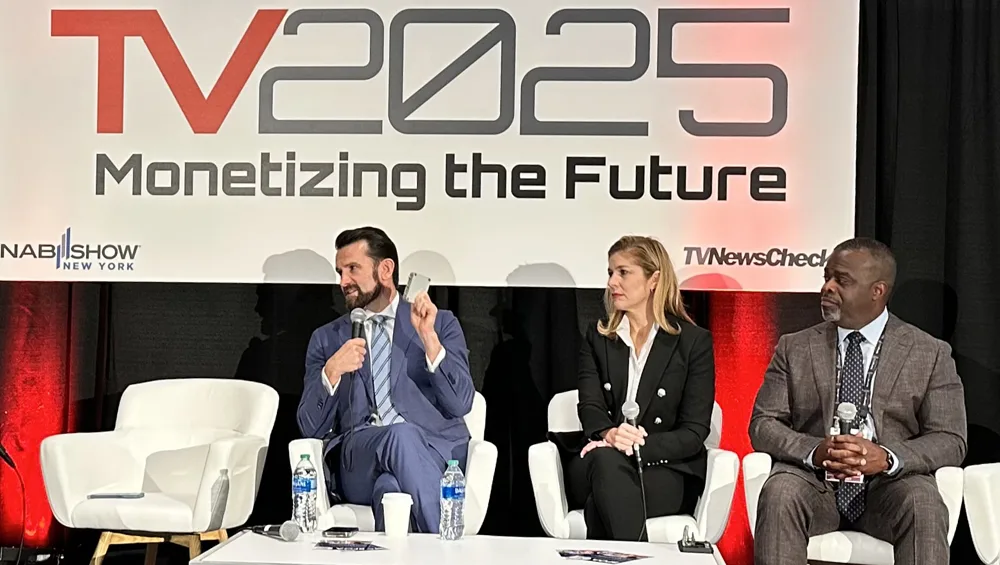
Station Group Execs Tackle Linear, Streaming, News, Networks And More

If there is a doubt in anyone’s mind that Allen Media isn’t serious about wanting to buy The Walt Disney Co.’s broadcast properties, Princell Hair, president of Allen Media Broadcasting, laid them to rest at TVNewsCheck’s TV2025 conference on Wednesday.
“We are very interested in the ABC owned-and-operated stations and the network,” he said during a panel session featuring top station group executives. “But there’s not a process in place yet. There’s no investment bank to provide valuations, to start the process of acquisition. But when that does happen, there will only be one phone call that [Disney CEO] Bob Iger has to make.”
Iger stated earlier this year that linear television isn’t core to Disney’s business, but in Allen Media’s playbook, it certainly is. “The broadcast business is still very viable,” Hair said. “The NFL just did a deal going through 2033. I don’t think the NFL is going anywhere. It’s a huge driver of our business. And we still need local stations to inform and educate our communities.”
“I love to point out that linear is as popular as ever, we just call it FAST,” said Chris Ripley, Sinclair president-CEO. “Linear is often put out there as this doomed medium, but in fact it’s alive and well and will continue to be in the future.”
Just as major e-commerce businesses have both online and brick-and-mortar presences, so too are media companies meeting consumers where they are in a variety of ways, such as streaming, MVPD distribution, linear and direct-to-consumer bundles.
“What I think is embedded in what Bob was saying,” Ripley said, “was an acknowledgement that direct to consumer is very expensive. You take on significant amount of technology and marketing costs.” Referring to Disney’s recent distribution deal with Charter Communications, Ripley said that “there’s an acknowledgement that bundling is a better business model.” In fact, he believes we’re now in a period of the “great re-bundling.”
Catherine Badalamente, Graham Media Group president-CEO, said that there is room for a synergistic coexistence between linear and streaming. “My view is we need to make sure we’re there when consumers are looking for us — and they’re finding us. We don’t’ need to do massive marketing for them to find our programming. It’s supports the idea that we’re important to them.”
The session’s moderator, TVNewsCheck Editor Michael Depp, asked Badalamente if the writers strike, and the still-ongoing SAG-AFTRA actors strike, have illuminated anything for stations, in terms of a path forward. And she zeroed in on the impact of the lack of latenight shows during the Writers Guild of America strike, with no great lead-in to late news. “The ongoing conversation is, do we get back an hour from the networks and utilize that for our late news starting off earlier, especially in our eastern markets? Today that seems to make more and more sense. And I think what we saw with the strikes emphasized that even more.”
That doesn’t mean that adding more news is a good idea. “The problem for us as an industry is that all our newscasts look relatively the same,” Badalamente said. “If we’re going to add more hours of local news programming, it needs to look a lot different than it does today.”
“Our viewers have told us there’s a lack of differentiation and too much repetition,” added Hair. Speaking of the broadcast industry in general, he said: “We need to become more engaged with our communities, what’s happening in our communities and look at different kinds of content — whether it’s lifestyle, or businesses, or restaurants, or what have you — things that impact people on a daily basis.”
The panelists also discussed the pressures that take place within newsrooms related to pay and culture, and leadership efforts to examine how work is distributed.
“To me, [the staff issues are] emblematic of a situation where you’ve got an artificial regulatory framework that ends up with markets having four to six suppliers of video local news,” Ripley said. “The economic rationale to do that changed, significantly, a long time ago. It makes operating a newsroom a lot more challenging on issues like pay, on issues like how much [staff members] have to do. At the end of the day it comes down to a model that’s being forced on the industry.”
The panelists also discussed a trouble spot that exists between station affiliates and networks — specifically the networks’ practice of signing deals directly with virtual MVPDs, then passing along a share of the distribution revenue to stations. Stations contend that they should be negotiating directly with the vMVPDs.
“I would take umbrage with the notion that the network-affiliate relationship isn’t in good shape,” Ripley said. “Each network has about two billion reasons a year to think that it’s in good shape. That’s roughly what each affiliate group sends the various networks [in dollars]. That’s significant part of the economics for networks, which didn’t exist 10 years ago.”
Ripley added: “In terms of [the] virtual issue, I have a lot of confidence that it will get resolved. I see a world in the not-too-distant future when every distributor is a virtual distributor. I think that is just a matter of time. There is a phenomenon in technology where hardware becomes software over time. And a virtual MVPD is nothing more than getting rid of your set-top box and trading it in for an app. But the offering is essentially the same. So, in a world where every distributor is essentially virtual, this needs to get figured out.”
Read more coverage of TV2025 here.

























Comments (0)